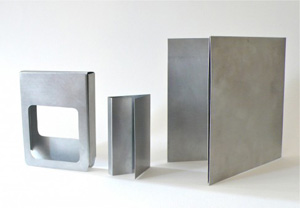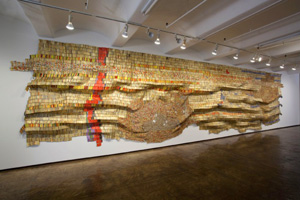7.7.25 — Really Minimal?
For once, it makes sense to have started on New York’s summer sculpture with the Met roof. True, it is not public sculpture in the city’s abundant parks, but the view brings it close enough. That is especially so with the roof about to close to bring it fully into the Met, as part of a redesign of its modern and contemporary wing.
 It has also been each year’s first to open (and I take you to more after their late openings, but first a quick tour of solo acts). With her interest in music, you might say that Jennie C. Jones set the tone for everything to come. In particular, it had me asking about the place of Minimalism in sculpture a mere half century after artists and critics alike pretty much moved on. Sure enough, Edra Soto and Torkwase Dyson could pass for the real thing.
It has also been each year’s first to open (and I take you to more after their late openings, but first a quick tour of solo acts). With her interest in music, you might say that Jennie C. Jones set the tone for everything to come. In particular, it had me asking about the place of Minimalism in sculpture a mere half century after artists and critics alike pretty much moved on. Sure enough, Edra Soto and Torkwase Dyson could pass for the real thing.
Both adopt industrial materials, with the warm browns of rusted steel. Both, too, work on a scale a bit larger than life, to invite viewers into the work. You can see through Edra Soto’s gates to others out for a stroll with Central Park behind them. If, like Jones, it is not quite art in the parks, it is this year’s commission for the park’s southeast entrance, across from the Plaza Hotel, and it welcomes the view, through August 24. Torkwase Dyson, in turn, creates a pavilion, with seating. The closer you get, though, the more it opens to the sky.
Both works do the unexpected for Minimalism, in accord with the eclectic “neo-Minimalism” common enough today. For such large, heavy sculpture, Soto’s could pass for painting. It divides neatly into four panels, each a geometric abstraction. Slim metal rods radiate outward, forming a surface at their center that reflects sunlight. And their radiance tells a story, about crossing borders. They recall for Soto the wrought-iron screens outside homes in her native Puerto Rico, and they rest on terrazzo within the picture plane, as if decorative tiling had taken flight.
Where Soto calls her work Graft, grafted onto her adopted city, this is Dyson’s Akua, meaning born on Wednesday, although I hesitate to ask why. Fresh off the 2024 Whitney Biennial, she has a lawn in Brooklyn Bridge Park, set back just far enough to make Brooklyn Heights, Dumbo, and the East River already distant memories. One can, though, see a shifting role for the work and its surroundings, through next March 8. What at first looks broad and solid, tapering in and out like the cooling tower of a nuclear reactor, reaches easily overhead. It also breaks up that much more clearly into metal beams with a circular opening above. A metal sheet on the ground could be the royal carpet inside.
Not that others can let go of Minimalism either, so long as they can run wild. Steve Tobin has his industrial roots, too, in more ways than one. His New York Roots, through February 28, began as piping before taking off in all directions exactly as the title would suggest. The half dozen works might have grown out of the ground here and there in the Garment District entirely on their own. Carl D’Alvia brings much the same party colors to the Upper West Side—and only a bit more restraint. His new work, on the Broadway median strip through November 1, plays on its compact shapes and single colors. It keeps threatening to settle down into geometric or alphabetic form, mostly near subway stops, only to refuse the offer.
But enough of abstract art, whatever the story line. How about the real New York, where pigeons are ready to prey on whatever you can offer? The spur of the High Line, near West 30th Street, has a history now of single works, through November with Iván Argote. Like a white drone by Sam Durant not long ago, Argote is thinking in terms of motion, although he titles his work Dinosaur, as if it were well past its prime. Like a bare tree by Pamela Rosenkranz just last year, he is thinking, too, in terms of natural life. His oversize pigeon, while beautifully detailed, looks a trifle obvious all the same.
Read more, now in a feature-length article on this site.


